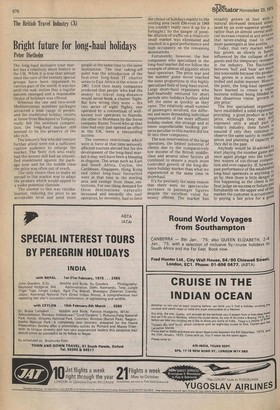Bright future for long-haul holidays
Peter Diethelm
The long-haul inclusive tour market has a relatively short history in the UK. While it is true that almost since the turn of the century special groups have been organised to various part of the world, it was not until the mid-'sixties that a regular pattern emerged and a reasonable choice of holidays was offered.
Whereas the one and two-week Mediterranean sunshine packages attracted a wide range of people, and the traditional holiday resorts at home from Blackpool to Torquay really felt the newborn competition, the long-haul market still seemed to be the preserve of the idle rich.
The leisurely few who did venture further afield were not a sufficient captive audience to enlarge the market. The torn' rich who really had the money still had an unjustified resentment against the package tour and for the middle class the price was often out of reach. The only choice then to make an inroad in this market was to adapt the product which would appeal to a wider potential clientele.
The answer to this was rationalisation, reducing the price to an acceptable level and send more people at the same time to the same destination. The real taking-off point was the introduction of the first-ever long-haul IT charter series to East Africa in the winter of 1967. Until then many companies predicted that people who had the money to travel long-distance would never book a charter flight. But how wrong they were the two series of eight flights, one operated by a consortium of wellknown tour operators to Nairobi, the other to Mombasa by the Swiss company Kuoni Travel who at that time had only just opened an office in the UK, were a resounding success.
The currency restrictions which were in force at that time seriously affected tourism abroad but for the development of the long-haul market it may well have been a blessing in disguise. The areas such as East and South Africa, Ceylon, the Caribbean, Singapore, Hong Kong and other long-haul favourites were at that time in the sterling area and exempt from these. restrictions. For one thing demand for these destinations naturally increased and secondly the tour operators, by necessity, had to limit the choice of holidays mainly to the sterling area (with £50 even in 1968 you couldn't really rave it up for a fortnight). So the danger of possible dilution of traffic on a relatively small market was eliminated and resulted in a good performance and high occupancy on the remaining destinations.
Fortunately, however, the few companies who specialised in the long-haul market did not follow the example of almost all gigantic short. haul operators. The price war and the number game never reached the same proportions in this highly specialised field of long-haul travel. Large short-haul organisers who half-heartedly ventured for short periods into holidays further afield left the same as quickly as they came. The relatively small number of passengers involved, the different and 'more demanding individual requirements of the more affluent holiday-maker, the strange and at times unpredictable booking patterns peculiar to this market did not fit into their computers.
The non-intervention of the large operators, the limited potential of clients due to the comparatively low income of the British middleclass and several other factors all combined to ensure a much more controlled growth of the long-distance holiday market than what we experienced at the same time in short-haul.
It's for precisely the same reason that there were no spectacular increases in passenger figures despite the excellent value for money offered. The market has
Spectator November 23, 1974 steadily grown in line with 3 natural increased demand stimu' lated by an ever-superior product., rather than an almost unreal aryli. cial increase created at any price On that never-ending road to carry more passengers at less profits. Today, that very market whicn has grown as slowly is hard') influenced by the collapse of the giants and the temporary recession in the industry. The fluctuation between 'bull' and 'bear' are much less noticeable because the product has grown in a much more controlled and stable manner. More to the point, the long-haul operators have learned to create a viable business without being blinded IV, any vision 'growth a
y price.'
The few specialised organisers have established a solid reputation providing a good product at a fnIr price. Although they may still, represent only a small part n' today's industry, their future is assured if only they continue observe the same sanity in realistic prices and planning of capacitY as they did in the past. Anybody would be ill-advised to. start playing the number game and once again plunge into the turh11.lent waters of cut-throat comPetv bon and over capacity. If, however,' past performance of the establishev long-haul operators is anything go by, then there is little danger 0' this happening as the client is th,e final judge on success or failure an' fortunately on the upper end of tbo market the customer is accustornedd to paying a fair price for a P°


































 Previous page
Previous page